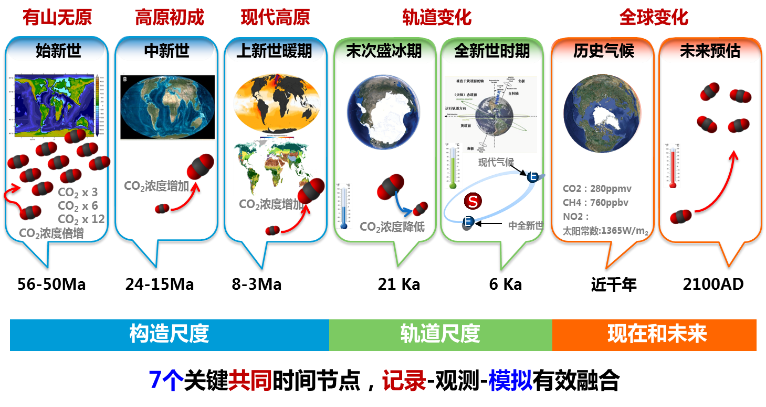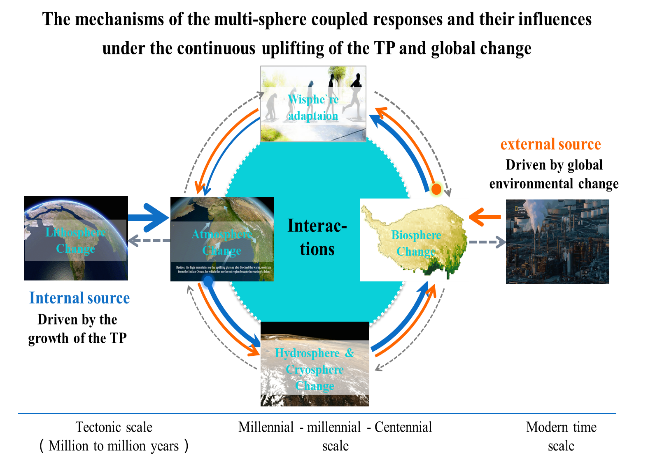

图2 项目综合集成思路
The Basic Science Center for Tibetan Plateau Earth System (CTPES) is a project founded by NSFC. This project is primarily based at the Institute of Tibetan Plateau Research, Chinese Academy of Sciences (CAS), along with two other participant institutions, the Institute of Atmospheric Physics of CAS and Peking University. Professor Fahu Chen (CAS Academician) is the project chief scientist, with key team members including Professor Lin Ding (CAS Academician), Professor Tianjun Zhou, Professor Baiqing Xu and Professor Shilong Piao. This outstanding research team with a well mixture of young and middle-aged scientists has been naturally formed during the development of CAS Center for Excellence in Tibetan Plateau Earth Science, and is highly esteemed in the Tibetan Plateau research.
The Tibetan Plateau (TP) is the region with the strongest and long-lasting plate collision on the Earth, and has been long considered the best place for verifying the theory of plate tectonics, a key scientific breakthrough in geology over the 20th century. The uplift of TP has fundamentally changed the environment of both its own region and that of tele-connected areas. And strong interactions of TP’s multiple spheres (lithosphere, atmosphere, cryosphere, hydrosphere, biosphere and anthroposphere) provide an extraordinary testing bed for Earth system science (ESS), likely leading to new breakthroughs in geoscience of the 21st century. In addition, the TP is renowned as “the Roof of the World”, “the Asian Water Tower” and “the Third Pole”, and plays a pivotal role as China’s ecological security barrier, reserve of strategic resources and preserve of national cultural heritage. The implementation of this project will not only satisfy the needs of ESS development, but also serve the strategic needs of national sustainable development.
Aiming at achieving innovative research and important breakthroughs in ESS of the 21st century, CTPES focuses on mechanisms of the multi-sphere coupled responses and their influences under the continuous uplifting of the TP and global change (Figure 1). Three major research directions of this project are outlined here: (a) Continental collision-subduction and plateau uplifting, (b) the coupled effects of westerly-monsoon synergy on cryosphere and water cycle, and (c) alpine ecology and human adaptation. Multidisciplinary methods that break boundaries of time, spheres, space and disciplines, and the development of the TP Earth system model will be the major research approach of this project, which will enable us to reconstruct the paleo-altitude and the chain responses in climate-biology-land surface processes at key historic nodes during the uplift of the TP (Figure 2). Such multidisciplinary and systematic approach can help reveal fundamental processes and mechanisms governing the interactions among contemporary Earth’s surface layers, and clarify the history and mechanism of human adaptation to this alpine environment.
The CTPES is expected to establish a paradigm of scientific research on the Tibetan Plateau Earth system science and make Chinese-characterized contributions to theories and applications of ESS. CTPES will bring up a number of strategic S&T talents, leaders and innovation teams and build an international frontier for ESS research, which will also support the regional sustainable development and ecological civilization over the TP and serve the strategic need of the Belt and Road Initiative.

Figure 1. Schematic diagram of core scientific issues of the Program

Figure 2. multidisciplinary and systematic approach of the program
Principle Investigator:Chen Fahu
Project duration:2020.1-2024.12


